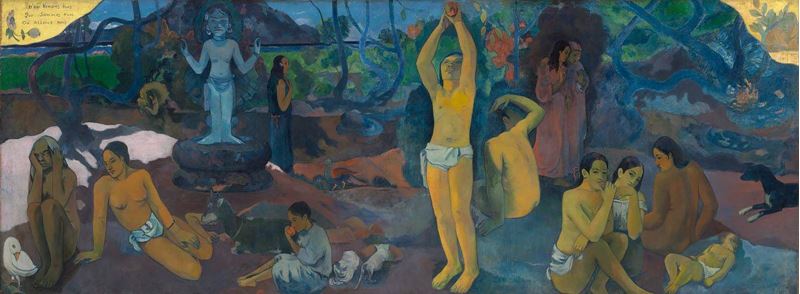Where Do We Come From? Who Are We? Where Are We Going? - Paul Gauguin
Where Do We Come From? Who Are We? Where Are We Going?, 897-1898, Oil on canvas, 139.1 x 374.6 cm, Museum of Fine Arts, Boston, USA.
Paul Gauguin left France and went to Tahiti, one of the Polynesian islands in the Pacific. In 1891, he went to Tahiti for the first time. Tahitian for Gauguin was an escape from everything that was artificial and traditional. He was also determined not to return from Tahiti for the second time in 1895. He was happy and hopeful about his life in this tropical country. But after a short while, he fell into a state of stricture. In 1894, during a journey to Brittany, he suffered from a painful injury to his feet and a disease in his eyes. His economic situation also deteriorated. In 1897, he was also depressed by the death of his sixteen-year-old daughter Aline. Gauguin, where bodily pain and despair dragged him to the point of committing suicide, made the biggest picture with his last word intention "Where do we come from? What are we? Where did we go?". Now he thought he had nothing to lose, he did not hesitate to use the rough brush strokes with excessive primitiveness in his painting.
This is the most important symbol of the second Tahitian period, with its elongated, transverse, giant-sized composition, the greatest symbol of the years of spiritual torture. This study is full of remnants of the artist's life from Tahiti to his own life. As an inventory of the world, there are people, animals, plants, rocks, water and sky in the picture. In the picture, whose basic colors are blue, green and orange, the human life, which is revealed, extends from birth to death. On the one hand, the newborn baby, who saw the sunlight for the first time and lying in the grass, represented the beginning of life; on the other hand, a tired and old woman looking at the sad eyes of the past symbolizes the end of life. These two figures have identified both ends of the scene. In the middle of the stage, the world of adults is full of joy and fear. In this composition, which is equipped with female figures with extremely primitive forms, on the one hand, the eastern god statue revealing local characteristics; on the other hand, there are two people walking around wrapping and thus creating an air that determines two dimensions of love.
Gauguin went to a nearby hill after finishing the painting, attempting to commit suicide by drinking arsenic on the hill. This intuition attempt led to his sick, not his death. This painting, in which the human condition conveys a visual interpretation, is his most recent work in which his will is embraced by his entire being to perform before his death, given that he attempted to poison himself. Gauguin, "Where do we come from? What are we? Where are we going?" for his work said: "Before I died, I wanted to perform a big picture that I carried in my head, and for the whole month, I burn the midnight oil, I worked with unprecedented enthusiasm.".
Bibliography;
Walther, I.F., (2005). Gauguin, Birinci Basım, Taschen/Remzi Kitabevi, İstanbul.
Çev:Göktepe, E., (2012). Gauguin, Birinci Baskı, Yapı Kredi Yayınları, İstanbul.
Spence, D., (2011). Büyük Ressamlar Gauguin, Birinci Basım, Koleksiyon Yayıncılık, İstanbul.
Eroğlu, Ö., (2014). Üç Postempresyonist Ruh Cézanne-Van Gogh-Gauguin, Birinci Baskı, Tekhne Yayınlar, İstanbul.
Altuna, S., (2013). Ünlü Ressamlar Hayatları ve Eserleri, Birinci Baskı, Hayalperest Yayınevi, İstanbul.
Cassou, J., (2006). Sembolizm Sanat Ansiklopedisi, Dördüncü Basım, Remzi Kitabevi, İstanbul.
Turani, A., (2010). Dünya Sanat Tarihi, On Dördüncü Baskı, Remzi Kitabevi, İstanbul.
Gauguin, P., (2002). Noa Noa, Birinci Baskı, İthaki Yayınları, İstanbul.













